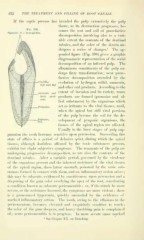Page 434 - My FlipBook
P. 434
;
432 THE TREATMENT AND FILLING OF ROOT CANALS.
If the septic process has invaded the l)ulp extensively the pulp
tissue, as its destmu^tion progresses, be-
Fici. 398.
comes the seat and soil of putrefactive
Pigment. S -I- hemoglobin.
decomposition involving also to a vari-
able extent the contents of the dentinal
tubules, and the color of the dentin un-
dergoes a series of changes.' The ap-
pended figure (Fig. 398) gives a graphic
diagrammatic representation of the serial
decomposition of an infected pulp. The
albuminous constituents of the pulp un-
dergo fatty transformation ; next putre-
factive decomposition attended by the
COo.NHa; evolution of hydrogen sulfid, ammonia,
H2O and HjS
and other end products. According to the
extent of invasion and its variety, waste
Aromatic and
fatty prod- products are formed (ptomains and al-
ucts.
lied substances) by the organisms Avhich
act as irritants to the vital tissues, until,
when the apical hut still vital portions
of the pulp become the soil for the de-
velopment of pyogenic organisms, the
tissues of the apical region are affected.
Usually in the later stages of pulp sup-
puration the tooth becomes sensitive upon percussion. Succeeding this
state of affairs is a period of delusive quiet, during which the apical
tissues, although doubtless aifected by the toxic substances present,
exhibit but slight subjective symptoms. The remnants of the pulp are
undergoing progressive decomposition, as are also the contents of the
dentinal tubules. After a variable period, governed by the virulence
of the organisms present and the inherent resistance of the vital tissues
of the ajneal region, these latter succumb, poisoned by the toxic sub-
stances formed in contact with them, and an inflammatory action arises
this may be sul)acute, evidenced by sensitiveness upon percussion and a
deepening of the gum color overlying the apex of the root, constituting
a condition known as subacute pericementitis ; or, if the attack be more
severe, or the resistance lessened, the symptoms are more violent ; there
is a pronounced hyperemia, quickly succeeded by the evidences of
marked inflammatory action. The tooth, owing to the eflPusions in the
pericementum, becomes elevated and exquisitely sensitive to touch
;
the color of the gum deepens, and heavy throbbing pain is complained
of; acute pericementitis is in progress. In more severe cases marked
^ See Chapter XX. on Bleaching.
432 THE TREATMENT AND FILLING OF ROOT CANALS.
If the septic process has invaded the l)ulp extensively the pulp
tissue, as its destmu^tion progresses, be-
Fici. 398.
comes the seat and soil of putrefactive
Pigment. S -I- hemoglobin.
decomposition involving also to a vari-
able extent the contents of the dentinal
tubules, and the color of the dentin un-
dergoes a series of changes.' The ap-
pended figure (Fig. 398) gives a graphic
diagrammatic representation of the serial
decomposition of an infected pulp. The
albuminous constituents of the pulp un-
dergo fatty transformation ; next putre-
factive decomposition attended by the
COo.NHa; evolution of hydrogen sulfid, ammonia,
H2O and HjS
and other end products. According to the
extent of invasion and its variety, waste
Aromatic and
fatty prod- products are formed (ptomains and al-
ucts.
lied substances) by the organisms Avhich
act as irritants to the vital tissues, until,
when the apical hut still vital portions
of the pulp become the soil for the de-
velopment of pyogenic organisms, the
tissues of the apical region are affected.
Usually in the later stages of pulp sup-
puration the tooth becomes sensitive upon percussion. Succeeding this
state of affairs is a period of delusive quiet, during which the apical
tissues, although doubtless aifected by the toxic substances present,
exhibit but slight subjective symptoms. The remnants of the pulp are
undergoing progressive decomposition, as are also the contents of the
dentinal tubules. After a variable period, governed by the virulence
of the organisms present and the inherent resistance of the vital tissues
of the ajneal region, these latter succumb, poisoned by the toxic sub-
stances formed in contact with them, and an inflammatory action arises
this may be sul)acute, evidenced by sensitiveness upon percussion and a
deepening of the gum color overlying the apex of the root, constituting
a condition known as subacute pericementitis ; or, if the attack be more
severe, or the resistance lessened, the symptoms are more violent ; there
is a pronounced hyperemia, quickly succeeded by the evidences of
marked inflammatory action. The tooth, owing to the eflPusions in the
pericementum, becomes elevated and exquisitely sensitive to touch
;
the color of the gum deepens, and heavy throbbing pain is complained
of; acute pericementitis is in progress. In more severe cases marked
^ See Chapter XX. on Bleaching.


